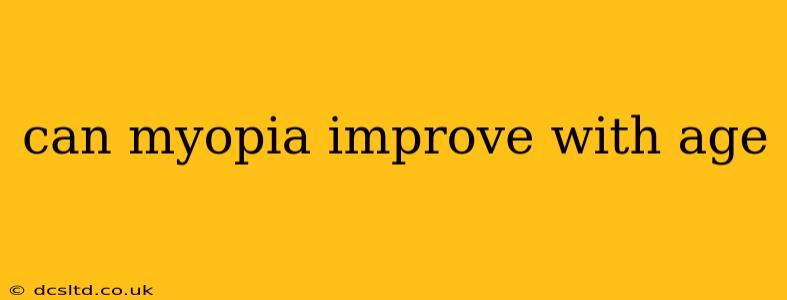Myopia, or nearsightedness, is a common refractive error where distant objects appear blurry. While it's often associated with childhood and adolescence, many wonder: can myopia improve with age? The answer is complex and depends on several factors. This comprehensive guide will explore the progression of myopia, potential changes with age, and what you can do to manage your vision.
Does Myopia Always Get Worse?
No, myopia doesn't always get worse. While myopia typically progresses during childhood and adolescence, the rate of progression slows significantly in the early twenties for most individuals. For some, progression may even stop completely. However, this isn't a guaranteed outcome, and for some individuals, myopia may continue to progress, albeit at a much slower pace, into their late twenties or even thirties. The age at which progression slows or stops varies greatly depending on individual factors.
Can Myopia Improve Naturally With Age?
While it's rare for significant improvement in myopia to occur naturally with age, a slight, subtle reduction in myopia is possible for some. This usually occurs as the eye's structure stabilizes in adulthood, but the improvement is typically minimal and may not be noticeable without a comprehensive eye examination. It's crucial to understand that this is not a common experience and shouldn't be relied upon as a method for correcting myopia.
What Factors Influence Myopia Progression and Potential Improvement?
Several factors influence how myopia progresses and the likelihood of any potential improvement with age:
-
Genetics: Family history of myopia is a strong predictor of developing the condition and its severity. Individuals with a strong family history are more likely to experience more significant myopia and a later cessation of progression.
-
Lifestyle: Near-work activities, such as prolonged reading, computer use, and other close-up tasks, have been linked to increased myopia risk and progression. Spending time outdoors has been shown to have a protective effect.
-
Age of Onset: Individuals who develop myopia at a younger age tend to experience a more significant degree of myopia and a longer period of progression.
-
Ethnicity: Myopia is more prevalent in certain ethnic groups, with East Asians having a higher rate of myopia compared to other populations.
-
Environmental Factors: While research is ongoing, some studies suggest that environmental factors, such as light exposure and diet, might play a role in myopia development and progression.
What Happens to Myopia in Your 30s and Beyond?
Beyond your early twenties, the progression of myopia typically slows considerably. While slight changes might occur, a significant worsening is less common. However, it's important to note that other age-related eye conditions can develop, such as presbyopia (difficulty focusing on near objects), cataracts, and macular degeneration. Regular eye exams are crucial throughout adulthood to monitor both myopia and the development of other eye conditions.
Can Treatments Help Manage or Improve Myopia?
While spontaneous improvement is unlikely, several treatments can manage myopia progression and potentially slow its advancement. These include:
-
Atropine Eye Drops: Low-dose atropine eye drops have shown effectiveness in slowing myopia progression in children.
-
Multifocal Contact Lenses: These lenses can help manage myopia progression in some individuals.
-
Orthokeratology (Ortho-k): This involves wearing special contact lenses overnight to reshape the cornea and temporarily correct myopia during the day. Some studies suggest ortho-k may also help slow myopia progression.
It's essential to consult with an ophthalmologist or optometrist to determine the most appropriate treatment for your individual situation.
Are there specific exercises to improve myopia?
While there are many claims about exercises improving myopia, there's currently limited scientific evidence to support the effectiveness of such methods in significantly improving or reversing myopia. Maintaining a healthy lifestyle, including regular outdoor time and breaks from near-work activities, is generally recommended. However, these measures are preventative rather than curative.
Conclusion
While significant natural improvement in myopia with age is uncommon, the rate of progression typically slows significantly in adulthood. Regular eye exams are essential for monitoring any changes in your vision and managing associated conditions. Various treatments are available to help manage myopia progression and maintain optimal vision. Always consult with an eye care professional for personalized advice and treatment options.
